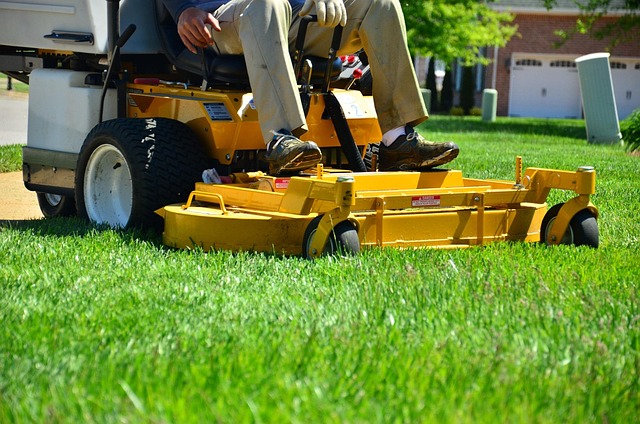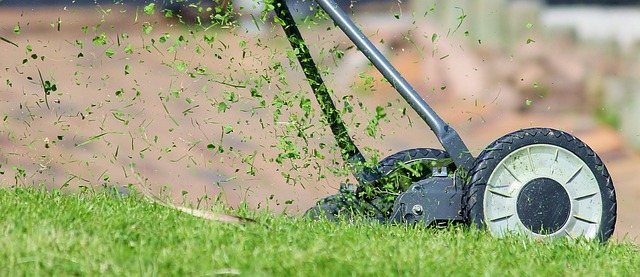Strategic lawn care and landscaping design transform outdoor spaces with tailored plans based on sunlight, soil, and vegetation. Incorporating native plants, drought-resistant species, and multi-functional areas reduces maintenance while enhancing visual appeal. Suitable grass types, regular care, and hardscape elements facilitate easier access and upkeep. A mix of plant varieties promotes biodiversity and minimal upkeep over time for a vibrant, eco-friendly landscape.
Landscaping design transforms outdoor spaces into vibrant, functional areas that enhance property values. This comprehensive guide explores the art of lawn care and landscaping implementation. From initial planning and strategic design choices to selecting the perfect plants and materials, we provide insights for optimal results. Learn effective techniques for successful installation and ongoing maintenance, ensuring your landscape not only looks stunning but also requires minimal upkeep. Discover how to create a thriving outdoor oasis that becomes the envy of the neighborhood.
- Planning and Design Strategies for Lawn Care
- Choosing Plants and Materials for Optimal Landscaping
- Effective Implementation and Maintenance Techniques
Planning and Design Strategies for Lawn Care

Effective lawn care and landscaping go hand in hand, as thoughtful planning and design strategies can transform outdoor spaces into lush oases. The first step involves assessing the existing landscape, taking note of factors like sunlight exposure, soil type, and existing vegetation. This information guides the creation of a tailored plan that considers both aesthetics and practicality. Incorporating features such as shade trees, drought-resistant plants, and multi-functional areas not only enhances visual appeal but also reduces maintenance requirements over time.
For lawn care, strategic planning involves deciding on grass types suited to the local climate and soil conditions, ensuring healthier, more vibrant turf. Regular maintenance practices, including proper watering, mowing, and fertilization schedules, should be integrated into the design itself. Additionally, designing walkways, patios, and other hardscape elements allows for easier access and care, while incorporating native plant species supports local ecosystems and reduces the need for chemical interventions.
Choosing Plants and Materials for Optimal Landscaping

When designing and implementing landscaping, selecting the right plants and materials is paramount for achieving optimal results in lawn care and overall outdoor aesthetics. The choice should align with your climate, soil conditions, and desired look—whether it’s a lush green garden or a low-maintenance desert landscape. Native plants are often recommended as they require less water and are better adapted to local environments, contributing to sustainable lawn care practices.
Materials such as gravel, pebbles, wood chips, and recycled plastics can enhance visual appeal and functional aspects like drainage while offering eco-friendly alternatives to traditional options. Incorporating a mix of plant varieties—including shrubs, flowers, and trees—not only adds color and texture but also supports biodiversity, ensuring a vibrant and healthy outdoor space that requires minimal upkeep over time.
Effective Implementation and Maintenance Techniques

Effective landscaping design isn’t just about creating an aesthetically pleasing outdoor space; it also requires thoughtful implementation and ongoing maintenance for long-lasting results. Once your dream landscape is designed, proper installation techniques become paramount. This includes ensuring accurate planting depth, proper spacing between plants, and secure placement of hardscape features like patios or retaining walls. Regular lawn care, such as mowing, fertilizing, and watering according to each plant’s needs, plays a crucial role in keeping your landscape healthy and vibrant.
Regular maintenance also involves seasonal tasks tailored to your climate. From spring clean-ups to fall leaf removal, these practices help keep your landscaping looking its best year-round. Additionally, staying vigilant for pests and diseases specific to your region is essential. Implement integrated pest management strategies and choose disease-resistant plant varieties to minimize damage and promote a balanced ecosystem in your lawn and garden.
Landscaping design is an art that transforms outdoor spaces into functional, aesthetically pleasing areas. By combining strategic planning, careful selection of plants and materials, and efficient implementation, homeowners can achieve a beautiful lawn care regime. Incorporating these techniques ensures a vibrant and well-maintained landscape that enhances property value and provides a tranquil outdoor environment. With the right approach, landscaping can be a game-changer for any outdoor space.



